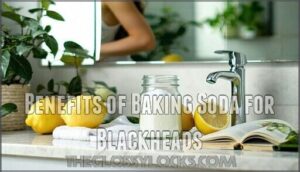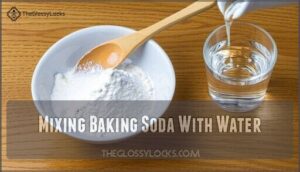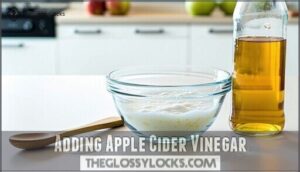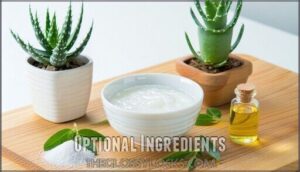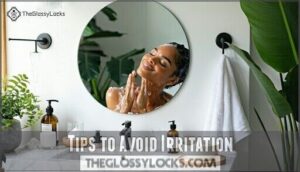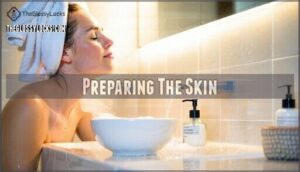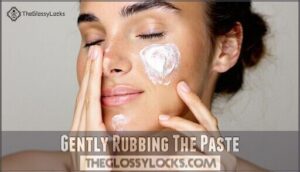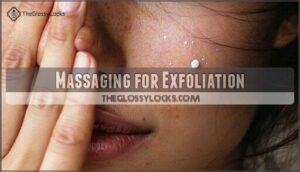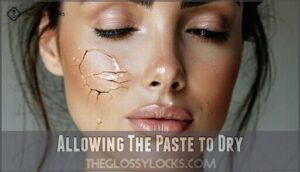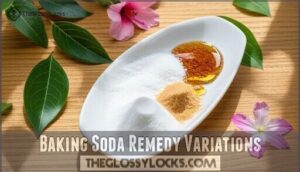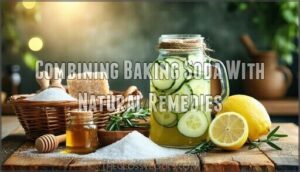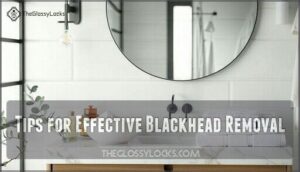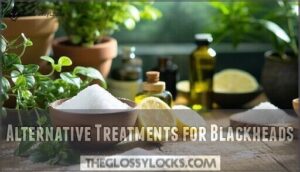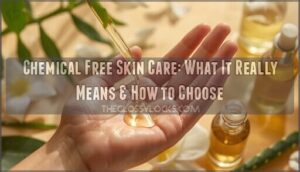This site is supported by our readers. We may earn a commission, at no cost to you, if you purchase through links.
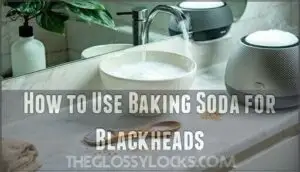
Steam your face first to open pores, then gently apply the paste using circular motions. Let it sit for 2-3 minutes before rinsing with lukewarm water.
The baking soda’s mild abrasive properties help remove dead skin cells and excess oil while its alkaline nature balances your skin’s pH. Use this treatment twice weekly maximum to avoid irritation.
Always patch test first and never apply to broken skin. While this kitchen staple offers an affordable alternative to expensive treatments, proper technique and timing make all the difference in achieving clear, smooth skin safely.
Table Of Contents
- Key Takeaways
- What Are Blackheads and Their Causes
- How to Use Baking Soda for Blackheads
- Benefits of Baking Soda for Blackheads
- Preparing a Baking Soda Paste
- Applying Baking Soda Paste Safely
- Baking Soda Remedy Variations
- Combining Baking Soda With Natural Remedies
- Safety Precautions and Side Effects
- Tips for Effective Blackhead Removal
- Alternative Treatments for Blackheads
- Frequently Asked Questions (FAQs)
- Can baking soda remove Blackheads?
- how can a teenager get rid of blackheads?
- How to get rid of Blackheads without irritating skin?
- How do you get rid of blackheads on your face?
- Does baking soda remove blackheads?
- How do you make baking soda scrub for blackheads?
- How to remove blackheads in 5 minutes?
- How to draw out a deep blackhead?
- Does diet impact the effectiveness of baking soda?
- How often should baking soda be used weekly?
- Conclusion
Key Takeaways
- Create a paste by mixing 2 parts baking soda with 1 part water, then gently apply using circular motions for 2-3 minutes before rinsing with lukewarm water.
- Steam your face first to open pores, which makes the treatment more effective and helps prevent irritation during application.
- Limit use to twice weekly maximum to avoid disrupting your skin’s natural pH balance and causing dryness or irritation.
- Always patch test on your wrist 24 hours before facial use and never apply to broken skin or active breakouts to prevent complications.
What Are Blackheads and Their Causes
Blackheads are small, dark bumps that appear on your skin when hair follicles become clogged with oil, dead skin cells, and bacteria.
Understanding what causes these stubborn spots helps you choose the right treatment approach and prevent future breakouts, by knowing the causes.
Definition of Blackheads
Blackheads are small, dark bumps that appear when hair follicles become clogged with oil and dead skin cells.
Those tiny dark spots on your nose aren’t dirt—they’re clogged pores oxidized by air exposure
Unlike whiteheads, these comedones remain open at the surface, allowing air to oxidize the trapped debris and create their characteristic dark appearance.
They’re not actually dirt—that’s a common misconception, and blackhead removal is a top skin care concern for achieving healthier, clearer-looking pores, affecting millions of people.
How Blackheads Form
Your skin’s sebaceous glands produce natural oils that travel through hair follicles to reach the surface.
When excess Skin Oil mixes with Dead Cells, it creates a plug within the follicle. This Follicle Clog becomes a blackhead when exposed to air, causing oxidation that darkens the material.
Here’s how Pore Blockage develops:
- Oil overproduction – Your glands work overtime, flooding follicles
- Cell buildup – Dead skin accumulates faster than it sheds naturally
- Oxygen exposure – The clogged material oxidizes, turning black
- Bacterial Growth – Trapped debris creates perfect conditions for bacteria
Common Causes of Blackheads
Multiple factors contribute to blackhead development beyond simple pore blockage.
Hormonal changes during puberty, menstruation, or pregnancy increase oil production, creating ideal conditions for blackheads.
Poor hygiene habits allow dirt and bacteria to accumulate, while genetic predisposition determines your skin’s natural oil levels.
Environmental factors like pollution and humidity also play significant roles in blackhead formation, and these elements combined create a complex scenario for skin’s natural oil levels.
Factors That Increase Risk
Various factors can amplify your blackhead troubles beyond basic causes.
Genetic predisposition plays a significant role – if your parents battled blackheads, you’re likely inheriting that struggle.
Your risk factors include:
- Hormonal fluctuations during puberty, menstruation, or pregnancy
- Poor hygiene habits that trap dirt and oil
- Environmental factors like pollution and humidity exposure
- Stress levels that trigger excess oil production
Understanding these triggers helps you choose effective treatments like natural skincare approaches.
How to Use Baking Soda for Blackheads
Understanding how blackheads develop sets the stage for learning effective treatment methods.
You can harness baking soda’s gentle abrasive properties to tackle these stubborn pores through several straightforward approaches.
The most common method involves creating a simple paste by mixing two parts baking soda with one part water. This baking soda face mask works as a natural acne treatment that gently removes dead skin cells and excess oil.
Here’s how you’ll apply this natural remedy:
- Steam first: Use facial steaming to open pores before application
- Gentle circles: Apply the baking soda scrub using light, circular motions
- Short contact: Leave on skin for only 2-3 minutes to prevent irritation
This blackhead removal technique offers significant baking soda benefits without harsh chemicals. The alkaline nature helps balance skin pH while providing effective blackhead prevention.
Remember, consistency matters more than intensity with these skin care tips – gentle, regular use trumps aggressive scrubbing every time.
Benefits of Baking Soda for Blackheads
When you understand blackheads’ stubborn nature, baking soda‘s multi-faceted approach becomes particularly appealing for your skincare routine.
This common household ingredient offers several scientifically-backed benefits that can help address blackhead formation through gentle yet effective mechanisms, making it a valuable addition to your routine with its scientifically-backed benefits.
Natural Exfoliant Properties
Baking soda’s gritty texture works like nature’s sandpaper, gently buffing away dead skin cells that trap oil and create blackheads.
This mechanical exfoliation reveals smoother skin underneath while clearing pores naturally.
| Exfoliant Benefits | Skin Texture Impact | Natural Remedies Advantage |
|---|---|---|
| Removes dead skin buildup | Creates smoother surface | Chemical-free alternative |
| Unclogs pores naturally | Reduces rough patches | Gentle peeling action |
| Promotes cell turnover | Improves overall texture | Safe for facial care |
PH Balancing Effect
Balancing your skin’s pH levels becomes easier when baking soda steps in to neutralize excess acidity that traps dirt in pores.
- Skin Balance: Restores ideal pH around 5.5 for healthy pore function
- Acid Neutralization: Counteracts acidic buildup from environmental pollutants
- Natural Remedies: Provides gentle alkaline action without harsh chemicals
- Facial Care: Creates ideal conditions for effective blackhead removal through proper pH management
The benefits of using baking soda for skin care include its ability to restore the skin’s natural balance, neutralize acidity, and provide a gentle remedy for various skin issues.
Antibacterial Action
Beyond balancing pH levels, baking soda’s antibacterial action provides additional bacterial control for your skincare routine.
This natural remedy creates an inhospitable environment for acne-causing bacteria, supporting skin purification through microbe balance.
Research indicates baking soda’s alkaline properties can inhibit certain bacterial strains that contribute to blackhead formation, making it effective for infection prevention when used appropriately in your acne treatment regimen.
Cost-Effectiveness
One major financial benefit of using baking soda for blackhead treatment involves significant cost savings compared to commercial alternatives.
Budget analysis reveals that baking soda costs under $2 per pound, providing economic value through dozens of homemade face mask applications.
This affordable treatment delivers substantial financial benefits, as most blackhead cure products cost $10-$25 monthly, making your pore minimizer solution become remarkably budget-friendly when you choose this versatile acne treatment option.
Preparing a Baking Soda Paste
Creating the right baking soda paste consistency guarantees effective blackhead treatment without causing skin irritation.
You’ll need to balance the ingredients carefully to achieve a gentle yet effective mixture that won’t damage your skin’s natural barrier.
Mixing Baking Soda With Water
Creating the perfect water ratio guarantees your baking soda paste works effectively for blackhead removal.
Mix one tablespoon of baking soda with just enough water to form a thick, spreadable consistency—typically two to three teaspoons.
This homemade face mask should feel gritty but not runny.
Proper skin preparation starts with clean hands and a gentle mixing motion to avoid clumps in your DIY skincare solution.
Understanding the right baking soda paste properties is vital for ideal results with your DIY skincare and blackhead removal efforts.
Adding Apple Cider Vinegar
Apple cider vinegar enhances your baking soda paste through its acidic properties, which complement the alkaline nature of baking soda for balanced skin toning.
This combination creates effervescent action that helps dislodge stubborn blackheads while providing gentle exfoliation.
- Mix equal parts baking soda and water, then add 2-3 drops of ACV for enhanced cleaning power
- Test patch first on your wrist to verify your skin tolerates this potent natural remedy combination
- Apply immediately after mixing since the fizzing reaction works best when fresh and active
Optional Ingredients
You can enhance your baking soda paste with natural ingredients to boost effectiveness for blackhead removal.
Essential oils like tea tree provide antibacterial benefits, while aloe vera soothes skin.
Herbal extracts and coconut oil add moisturizing properties to prevent over-drying during treatment.
| Ingredient | Purpose | Amount |
|---|---|---|
| Tea Tree Oil | Antibacterial action | 1-2 drops |
| Aloe Vera Gel | Soothing hydration | 1/2 teaspoon |
| Coconut Oil | Gentle moisturizing | Few drops |
Tips to Avoid Irritation
Why risk turning your natural skin care routine into a battle zone? Proper preparation prevents baking soda irritation and guarantees gentle exfoliation around sensitive areas.
Understanding common skin irritants is key to a successful skincare routine.
- Patch test first – Apply a small amount to your inner wrist 24 hours before facial use
- Start with minimal ratios – Mix one part baking soda with three parts water for beginners
- Avoid broken skin – Skip areas with cuts, active acne, or recent extractions
- Follow aftercare tips – Rinse thoroughly with cool water and apply gentle moisturizer immediately
Applying Baking Soda Paste Safely
Once you’ve prepared your baking soda paste, proper application technique guarantees effective blackhead removal while minimizing skin irritation.
The key lies in gentle, controlled movements that allow the paste to work without causing damage to your delicate facial skin, which is crucial for effective removal with minimal irritation.
Preparing The Skin
Once you’ve prepared your paste, proper skin preparation sets the foundation for safe and effective blackhead removal.
Start with thorough skin cleansing using lukewarm water to remove surface dirt and makeup. Pat your face dry with a clean towel, then apply gentle steam or warm compress to open pores naturally.
| Preparation Step | Method | Purpose |
|---|---|---|
| Initial Cleansing | Gentle cleanser + lukewarm water | Remove surface impurities |
| Steam Treatment | Warm towel or steam (2-3 minutes) | Open pores for better penetration |
| Skin Assessment | Check for cuts, irritation, or sensitivity | Prevent adverse reactions |
| Area Selection | Target T-zone and affected areas | Focus treatment where needed |
| Final Prep | Pat dry, make certain clean hands | Maintain hygiene standards |
This systematic approach to skin preparation maximizes the effectiveness of your baking soda treatment while minimizing potential irritation risks.
Gently Rubbing The Paste
Once you’ve prepared your skin, it’s time to apply the baking soda mixture with precision.
The key lies in using controlled pressure to avoid damaging delicate facial tissue.
Follow these gentle application steps:
- Use fingertips only – Apply light pressure using circular motions
- Work in small sections – Focus on one area at a time for even coverage
- Avoid sensitive zones – Skip the delicate eye and lip areas completely
This careful approach guarantees effective blackhead removal while protecting your skin’s natural barrier during facial care routines.
Massaging for Exfoliation
Once you’ve rubbed the paste onto your skin, begin massaging using small circular motions for thirty seconds.
This gentle scrubbing technique promotes effective exfoliation without damaging delicate facial tissue.
Focus on blackhead-prone areas like your nose and chin.
Proper massage techniques enhance the baking soda’s natural abrasive properties, helping loosen stubborn debris from pores while maintaining safe skin care practices and promoting effective removal of debris.
Allowing The Paste to Dry
After the gentle massage, let the baking soda paste settle on your skin for ideal blackhead removal. Drying time typically ranges from 10-15 minutes, depending on paste thickness and skin preparation.
- Monitor drying progress – paste should feel firm but not completely hardened
- Avoid excessive drying – prevents skin irritation and maintains natural moisture
- Check for tightness – slight pulling sensation indicates proper drying methods
- Prepare removal tools – warm water or gentle blackhead extractor for aftercare tips
- Stay hydrated – drink water while waiting to support overall skin care tips
Baking Soda Remedy Variations
You can customize your baking soda blackhead treatment by combining it with other common household ingredients for enhanced benefits.
These variations offer different properties, from moisturizing honey to exfoliating sugar, allowing you to tailor the remedy to your specific skin needs, with enhanced benefits.
Baking Soda and Toothpaste
Combining toothpaste with baking soda creates an abrasive mixture that may temporarily improve blackhead appearance through enhanced exfoliation.
However, toothpaste contains whitening agents and fluoride designed for oral care, not facial skin. This combination can disrupt your skin’s natural pH balance and cause irritation.
Natural remedies like this lack clinical evidence for effective blackhead removal, unlike proven blackhead extractor tools and targeted skin care tips from dermatologists.
For those seeking alternatives, considering a natural toothpaste alternative can be a key step in avoiding harsh chemicals and finding a suitable toothpaste alternative.
Baking Soda and Honey
Honey’s natural antibacterial properties make it an excellent partner for baking soda in blackhead removal.
This gentle combination provides effective exfoliation while moisturizing your skin, preventing the dryness that often accompanies harsh treatments.
Here’s how to create this soothing face mask:
- Mix one tablespoon baking soda with two tablespoons raw honey
- Apply the paste to damp skin using circular motions
- Leave on for 10-15 minutes before rinsing with warm water
Baking Soda and Lemon
Lemon juice amplifies baking soda’s exfoliant properties, creating a potent natural remedy for blackhead removal.
This citrus addition provides vitamin C and mild acidic benefits that complement alkaline baking soda.
Mix equal parts baking soda and fresh lemon juice for an effective face mask. The combination offers enhanced skin purification while maintaining gentle acne solutions for facial care routines.
Baking Soda and Sugar
If you’re curious about Sugar Scrubs, mixing baking soda and sugar creates a Natural Exfoliant for your Facial Routines.
Here’s how to use it for Skin Benefits and blackhead removal tips:
- Blend equal parts sugar and baking soda.
- Gently massage onto damp skin.
- Rinse thoroughly and moisturize.
This Baking Soda Mask supports facial care and acne solutions.
Combining Baking Soda With Natural Remedies
You can boost baking soda’s blackhead-fighting power by combining it with other natural ingredients that target different aspects of skin care.
This approach allows you to customize your treatment based on your specific skin needs while maintaining the gentle, cost-effective benefits of homemade remedies.
Using Apple Cider Vinegar as Toner
After exploring various baking soda mixtures, apple cider vinegar serves as an excellent complementary toner for facial balancing.
ACV benefits include restoring your skin’s natural pH after exfoliation treatments.
Mix one part vinegar with three parts water for effective skin toning.
This vinegar uses approach enhances blackhead removal tips by preparing pores for better cleansing.
The toner recipes provide gentle skincare benefits while supporting your baking soda uses routine through proper utilization.
Adding Essential Oils
Essential Oil Blends can enhance baking soda’s skincare benefits through targeted aromatherapy benefits.
Tea tree and lavender oils offer antibacterial properties when properly diluted.
Mix 2-3 drops with carrier oil before adding to your paste for safe application.
Always consider skin sensitivity when selecting oils.
This utilization requires proper oil dilution ratios to prevent irritation while maximizing fragrance therapy effects.
Using a natural face scrub routine can also help to achieve better skincare results, with a focus on skincare benefits.
Incorporating Other Exfoliants
When incorporating other exfoliants with baking soda, proceed with caution to prevent over-exfoliation and skin damage.
Combining multiple exfoliating agents requires careful consideration of skin tolerance and proper application timing for safe utilization.
- Chemical Peels: Avoid combining glycolic acid treatments with baking soda on the same day
- Microdermabrasion: Schedule professional treatments separate from home baking soda employment
- Enzyme Exfoliants: Use fruit enzymes on alternating days for balanced exfoliation purpose
- Physical Exfoliants: Limit sugar or salt scrubs when using baking soda regularly
- Professional Guidance: Consult dermatologists before layering multiple exfoliation methods
Customizing Your Routine
Different skin types demand unique approaches to Skin Care Tips and Routine Adjustments.
Your purpose should guide Product Combinations—sensitive skin benefits from honey additions, while oily skin responds well to lemon integration.
Daily Habits matter more than frequency; consistent application twice weekly outperforms sporadic use.
Tailor your Beauty Routines by monitoring skin response and adjusting employment of ingredients accordingly for maximum utilization of Daily Habits.
Safety Precautions and Side Effects
While baking soda can effectively treat blackheads, you’ll need to understand potential risks to protect your skin from harm.
Proper precautions prevent irritation, allergic reactions, and other complications that could worsen your skin condition, and following these guidelines is crucial for using baking soda safely, emphasizing the importance of precautions.
Avoiding Open Wounds
Never apply baking soda to broken skin, cuts, or active breakouts. The alkaline properties can disrupt natural wound care processes and delay healing.
For sensitive skin protection, perform a patch test first. If you notice irritation, discontinue use immediately.
Gentle cleansing around wounds prevents infection while allowing proper healing. Always prioritize skin protection over aggressive application methods.
Maintaining good skin health habits is essential for overall wellness.
Overuse and Irritation Risks
Excessive utilization of baking soda can trigger skin irritation and over exfoliation, stripping your skin’s natural protective barrier.
Daily application may cause baking soda burns, particularly on sensitive skin types.
Limit consumption to twice weekly maximum to prevent exploitation of your skin’s delicate balance and avoid compromising its natural defenses.
Allergic Reactions
Although baking soda allergic reactions remain uncommon, certain individuals may develop contact dermatitis characterized by redness, itching, or swelling upon application.
Those with sensitive skin face heightened risk for histamine response following utilization on compromised skin barriers.
Conduct patch tests before employment on facial areas—apply a small amount to your forearm and monitor for 24 hours.
Reaction symptoms typically resolve when use discontinues immediately.
Understanding contact dermatitis causes is essential for identifying potential allergens and irritants that may trigger such reactions.
When to Consult a Dermatologist
Seeking professional skin care guidance becomes necessary when baking soda application causes persistent problems.
Medical advice helps address complex skin conditions that home remedies can’t resolve effectively.
Consider scheduling a dermatologist visit when you experience:
- Severe irritation lasting beyond 24 hours after use
- Signs of infection like pus or spreading redness
- Worsening blackhead conditions despite consistent employment of treatments
- Underlying skin conditions requiring specialized blackhead removal techniques
Professional evaluation guarantees safe utilization for your specific needs, ensuring the effective treatment of skin conditions.
Tips for Effective Blackhead Removal
Achieving effective blackhead removal with baking soda requires a strategic approach that balances thorough cleansing with skin protection.
You’ll want to establish consistent application patterns while monitoring your skin’s response to prevent irritation and maximize results.
This approach will help you achieve effective blackhead removal.
Regular Use Recommendations
Dermatologist’s frequency guidelines recommend limiting baking soda application to 1-2 times weekly for ideal results. This dosage control prevents skin irritation while maintaining effectiveness.
Your skin preparation routine should include patch testing before regular employment. Treatment duration shouldn’t exceed 5-10 minutes per session to avoid disrupting your skin’s natural barrier.
Following this maintenance routine guarantees safe utilization for blackhead removal without compromising skin health or triggering adverse reactions. To achieve the best results, understanding blackhead causes is vital for effective treatment and prevention.
Proper Exfoliation Techniques
Proper exfoliation methods vary considerably based on individual skin types and require careful application for ideal results.
When using baking soda for blackhead removal, gentle scrubbing motions prevent micro-tears while facial massage techniques enhance circulation.
Your daily routine should incorporate these measured approaches to maintain healthy skin without compromising its protective barrier.
- Small circular motions with fingertips distribute the paste evenly across affected areas
- Light pressure prevents irritation while allowing the baking soda’s natural abrasive properties to work
- Brief contact time of 2-3 minutes maximizes the treatment’s purpose without overexposure
Avoiding Over-Exfoliation
Everyone knows the temptation to scrub harder when blackheads persist, but overdoing exfoliation with baking soda can compromise your skin barrier and trigger irritation.
Gentle skincare requires restraint—limit baking soda application to twice weekly maximum.
Watch for redness, stinging, or excessive dryness, which signal you’re pushing too hard.
The purpose of exfoliation tips isn’t aggressive removal but gradual improvement.
Your daily routine should prioritize sensitive care over intensive treatment.
Remember, consistent gentle use delivers better results than sporadic harsh utilization.
Following With Moisturizer
After you use baking soda treatments, applying moisturizer becomes your skin’s best friend.
The exfoliation process can temporarily strip natural oils, making hydration the perfect finishing touch.
Choose a non-comedogenic moisturizer for daily routine aftercare.
This application restores skin balance, prevents dryness, and maximizes the benefit of your blackhead removal efforts.
Proper product selection guarantees your skin stays healthy and protected, and ensures that the blackhead removal efforts are effective.
Alternative Treatments for Blackheads
If baking soda doesn’t work for your blackheads or causes irritation, you’ve got several other effective options to try.
Professional dermatologists recommend salicylic acid cleansers, tea tree oil treatments, gentle sugar scrubs, and in-office extractions for stubborn cases.
Salicylic Acid Cleansers
Salicylic acid cleansers represent proven acne treatment options that effectively penetrate pores and dissolve stubborn blackheads.
These exfoliating products contain beta hydroxy acids that work deeper than surface-level skin care solutions.
Clinical studies demonstrate 25-35% blackhead reduction after four weeks of consistent application, and many users find success with a salicylic acid product as part of their skincare routine.
Unlike harsh DIY methods, gentle formulas with 0.5-2% concentrations provide reliable utilization for daily facial cleansers without excessive irritation risks.
Tea Tree Oil Applications
Beyond traditional acne treatment methods, tea tree oil serves as a potent natural remedy for blackhead removal through targeted application techniques. This essential oil’s antimicrobial properties make it an effective skin care solution when properly diluted for safe employment on affected areas.
- Dilute tea tree oil with a carrier oil (coconut or jojoba) using a 1:10 ratio for safe application
- Apply the mixture directly to blackheads using a cotton swab for precise utilization
- Leave the oil benefits to work for 10-15 minutes before rinsing with warm water
- Incorporate this natural remedies approach into your aromatherapy routine for enhanced purpose and relaxation
Sugar and Salt Exfoliation
Several types of exfoliating scrubs can complement your blackhead removal routine.
Sugar offers gentle utility as a natural peel, breaking down dead skin cells without harsh abrasion.
Salt provides deeper application for stubborn areas, though it requires careful facial massage techniques.
Both options improve skin texture when combined with gentle cleansers.
The definition of effective exfoliation means finding your skin’s sweet spot—too aggressive destroys your natural barrier, which is crucial for maintaining healthy skin through gentle cleansers.
Professional Extraction Methods
Dermatologists routinely employ specialized extraction tools during professional treatments to safely remove stubborn blackheads.
These procedures involve thorough skin analysis, followed by facial steaming to open pores for efficient pore cleansing.
The precise application of comedone extractors guarantees minimal trauma while achieving effective blackhead removal.
Professional utilization of these techniques serves the specific purpose of deep cleansing without causing scarring or infection risks.
Effective blackhead removal also involves understanding the importance of skin care routines to prevent future breakouts, which is a key aspect of professional treatments.
Frequently Asked Questions (FAQs)
Can baking soda remove Blackheads?
While you might think baking soda’s gritty texture helps exfoliate blackheads, it’s too harsh for delicate facial skin.
Baking soda can disrupt your skin’s natural pH balance, causing irritation and potentially worsening breakouts rather than clearing them effectively, which is why using baking soda is not recommended.
how can a teenager get rid of blackheads?
You’ll target blackheads with gentle cleansers containing salicylic acid, wash twice daily, avoid picking, use non-comedogenic moisturizers, and consider over-the-counter treatments. Consistency beats aggressive scrubbing every time.
How to get rid of Blackheads without irritating skin?
Gently cleanse twice daily with salicylic acid, use clay masks weekly, and avoid harsh scrubbing. Choose non-comedogenic products, stay hydrated, and resist picking to prevent inflammation and scarring.
How do you get rid of blackheads on your face?
Use salicylic acid washes once daily and retinoid creams to unclog pores. Consider professional extraction by dermatologists for stubborn cases. Never squeeze with fingernails to avoid scarring.
Does baking soda remove blackheads?
Notably, research confirms your skincare instincts aren’t wrong.
Baking soda can help clear skin of blackheads, but experts caution it’s quite abrasive and risky.
You’ll find gentler chemical exfoliants work better without damaging your skin’s protective barrier.
How do you make baking soda scrub for blackheads?
Creating this paste involves mixing two teaspoons of baking soda with warm water until you achieve a thick consistency.
However, dermatologists warn that baking soda’s high pH of 9 disrupts skin’s natural acidic balance, potentially causing irritation and dryness.
How to remove blackheads in 5 minutes?
Steam your face first to open pores, then apply salicylic acid cleaner or pore strip to affected areas.
Wait the recommended time, gently remove with pressure.
Follow up with toner to close pores.
How to draw out a deep blackhead?
Gently warm a washcloth with hot water and press it against the stubborn blackhead for several minutes.
This softens the pore’s contents, making extraction easier and safer than aggressive squeezing methods.
Does diet impact the effectiveness of baking soda?
Want the golden key to blackhead freedom?
Your diet plays virtually no direct role in how well baking soda works on your skin.
However, a diet high in refined sugars and unhealthy fats can lead to inflammation and contribute to blackheads, affecting their formation regardless of your treatment choice, which is a crucial factor in achieving blackhead freedom.
How often should baking soda be used weekly?
You shouldn’t use baking soda more than once or twice weekly.
Experts recommend one to two applications per week maximum to prevent over-drying and irritation.
Your skin needs recovery time between treatments for best results.
Conclusion
Studies show nearly 85% of people experience blackheads at some point, making this a universal skincare concern.
Learning how to use baking soda for blackheads offers an accessible solution when applied correctly.
This natural remedy provides gentle exfoliation and pH balance, but success depends on proper technique and frequency.
Remember to patch test first, limit treatments to twice weekly, and always follow with moisturizer.
While baking soda can effectively address blackheads, discontinue use if irritation occurs and consult professionals for persistent concerns.
- https://docs.google.com/forms/d/1GAQr3Kn1cURCVHUA82hAga1Wv8DCH0IuqDLRUrOpN7M/viewform?ts=63f4f653&entry.1515682415=https://www.merriam-webster.com/dictionary%2Fuse
- https://premium.britannica.com/mw-unabridged/?utm_source=mw&utm_medium=inline-def&utm_campaign=evergreen
- https://dictionary.cambridge.org/dictionary/english/adopt?topic=using-and-misusing
- https://idioms.thefreedictionary.com/avail+(oneself)+of
- https://www.thesaurus.com/browse/use

